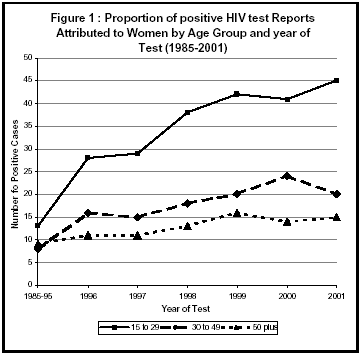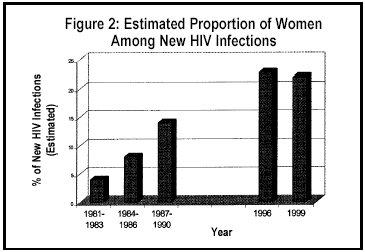Common menu bar links
Institutional links
Diseases & Conditions
Health & Safety
Research & Statistics
Agency Information
Search Box
E-mail this page
HIV and AIDS Among Women in Canada
HIV/AIDS Epi Updates
April 2003
Download all of the HIV/AIDS Epi
Updates
82 pages (1,223 KB) in PDF format ![]()
(How to download PDF
documents)
HIV and AIDS Among Women in Canada
Introduction
The HIV/AIDS epidemic in Canada has changed from the early epidemic that affected primarily men who have sex with men (MSM) to the current epidemic, which increasingly affects other groups such as injecting drug users (IDU) and heterosexuals. As a result of this shift, HIV/AIDS affects a growing number of women. The HIV/AIDS epidemic among women is of particular concern because of the potential for transmission to their infants. This report updates the status of HIV and AIDS among adult and adolescent women (15 years and older) in Canada.
AIDS
In Canada, of the 18,124 cumulative AIDS cases in adults reported up to June 30, 2002 to the Centre for Infectious Disease Prevention and Control (CIDPC), 1,437 (7.9%) were among women. The proportion of AIDS cases among women (relative to all reported AIDS cases in adults for which gender and age are known) has increased over time, from 5.6% before 1992 to 8.3% in 1995 and peaking at 16.4% in 1999. In 2001, the proportion of AIDS cases among women has remained at 16%.1
Of all cumulative reported AIDS cases in women, 67.4% are attributed to heterosexual contact, 22.9% to injecting drug use and 9.5% to recipients of blood and blood products. There has been a steady increase in the proportion of adult female AIDS cases attributed to IDU, from 17.8% prior to 1996 to 26.6% in 1996 and 34.9% in 2000.
HIV
AIDS data can contribute to an understanding of trends in HIV infections, but only on those acquired approximately 10 years in the past. In contrast, positive HIV test reports provide a picture of more recent infections. Data from provincial and territorial HIV testing programs indicate that a total of 6,250 positive HIV tests with known age and gender have been reported in adult women up to June 30, 2002.1
Women account for a growing proportion of positive HIV tests reports with known age and gender among adults in Canada. The proportion of females each year has risen, from 9.7% in the years between 1985 and 1995 to nearly 25% of adult positive HIV test reports between January 1999 and December 31, 2001. In the first half of 2002, this proportion increased slightly to 25.8%. The proportion of women among positive HIV tests vary considerably by age and is highest among adolescents and young adults (Figure 1). In 2001, women accounted for 44.5% of positive HIV test reports among those aged 15 to 29 years, an increase from 41% in 2000. In the first half of 2002, this proportion decreased slightly to 42%.1

Among women, the primary exposure categories associated with newly diagnosed HIV infection are heterosexual contact and IDU (Table 1). The proportion of HIV tests in females attributed to heterosexual contact has increased over time from 46% for the period 1985-1996 to 62% in 2001. The proportion attributed to IDU has however remained fairly constant at around 36% (Table 1). Heterosexual contact still remains the main risk factor for HIV infection in women. However, injecting drug use continues to be a significant risk for HIV among Canadian women and in some studies this risk is greater for female IDUs than for male IDUs.2
Table 1: Proportion of Positive HIV Tests among Adult Females by Exposure Category and Year of Test, Canada (1985-2002) 1
|
||||||||||||||||||||||||||||||||||||||||
* Data to June 30, 2002.
HIV Incidence Estimates Suggest Rising Number of New Infections Among Women in Canada
Data from positive HIV test reports do not provide the complete picture of the annual number of new HIV infections since only a proportion of those newly infected are tested in the same year. Furthermore, not all HIV tests reported in a given year were infected in that year. The CIDPC has estimated the annual number of new HIV infections using information from AIDS case reports, provincial HIV testing databases, population-based surveys, targeted epidemiologic studies, and census data. In 1999, approximately 4,190 persons in Canada became newly infected with HIV, with an estimated 920 (21.9%) among women.3 The estimated proportion of women among new HIV infections has increased since the 1980s. In 1996 and 1999, it was estimated that women accounted for more than one of every five new infections3 (Figure 2).

These recent estimates also indicate that the number of women in Canada living with HIV, including those with AIDS, continues to grow. By the end of 1999, an estimated 6,800 women were living with HIV, an increase of 48.0 % from the 1996 estimate of 4,600.3
HIV among Pregnant Women and Women of Childbearing Age
HIV testing during pregnancy is an option available to women across Canada. However, physician guidelines and/or recommendations encouraging informed decisions regarding HIV testing during pregnancy vary by province and territory. These are discussed in detail in the Epi Update entitled "Perinatal Transmission of HIV," April 2003.
HIV prevalence studies among pregnant women can provide an important source of information on the prevalence rate of HIV in the general heterosexual population. Prenatal seroprevalence studies in Canada report an estimated national rate of HIV infection among pregnant women of 3-4/10,000 population.
Large metropolitan areas report higher rates of HIV infection among pregnant women (4.7 for Vancouver versus 3.4 for the rest of B.C. in 1994.4 15.3 for Montreal versus 5.2 for the province of Quebec in 19905). Even provinces without large metropolitan areas have indicated significant rates (for example, 4.1/10,000 in New Brunswick for 1994-966). Data from Manitoba suggest an increasing trend of HIV infection among women of childbearing age, from 0.7/10,000 in 1991 to 3.2/10,000 in 1994-95.7 A study is ongoing in B.C. to update the prevalence estimates of HIV among pregnant aboriginal women.
An ongoing HIV seroprevalence study among pregnant women in Ontario reported a rate of 3.7/1000.8 This rate is based on pregnant women who voluntarily tested (approximately 70%) whereas the rates in the other provinces are based on complete samples from unlinked anonymous studies.
Comment
Women in Canada are increasingly becoming infected with HIV, especially injecting drug users and women with high-risk sexual partners. Efforts to reduce transmission of HIV will need to focus on promoting safer sexual behaviours and reducing substance abuse.
All women, and especially women of childbearing age, should have access to HIV testing, counselling and care. Better data on the trends, risk factors and geographic shifts of HIV among Canadian women are needed to help target prevention and care programs.
References
-
Health Canada. HIV and AIDS in Canada. Surveillance report to June 30, 2002. Division of HIV/AIDS Epidemiology and Surveillance, Centre for Infectious Disease Prevention and Control, Health Canada, November 2002.
-
Spittal PM, Craib KJP, Wood E, Laliberté N, Li K, Tyndall MW, O'Shaughnessy MV, Schechter MT. Risk factors for elevated HIV incidence rates among female injection drug users in Vancouver. CMAJ 2002; 166(7): 894-899.
-
Geduld J, Archibald C. National trends of AIDS and HIV in Canada. CCDR. 2000; 26:193-201.
-
Pi D, Ballem PJ, Schechter MT. The B.C. Prenatal Study: 1989-94. Final report to LCDC; January 1995.
-
Hankins C, Hum L, Tran T et al. HIV seroprevalence in women giving birth to live infants in Northern Quebec (1989-93). Can J Infect Dis 1995; 6 Suppl B:39 {Abstract 314} 1995.
-
Getty G, Leighton P, Mureika R et al. NB antenatal seroprevalence study. Can J Infect Dis 1997; 8:24A {Abstract 205} 1997.
-
Blanchard J, Hammond G, Fast M et al. HIV serovalence among antenatal women in Manitoba: August, 1994 through August, 1995. Final report to LCDC 1996.
-
Remis S. Robert, Carol Swantee, Carol Major, Margaret Fearon, Evelyn Wallace, Robert WH Palmer, Peggy Millson, Liviana Calzavara, Elizabeth Rea, Susan King, Keyi Wu, Marian Vermeulen and Elaine Whittingham. Increasing HIV testing of pregnant women in Ontario: Results from the HIV seroprevalence study to September 2002. Unpublished data.
For more information please contact:
| Division of HIV/AIDS
Epidemiology & Surveillance Centre for Infectious Disease Prevention & Control Public Health Agency of Canada Tunney's Pasture, Postal Locator 0900B1 Ottawa, ON K1A 0L2 Tel: (613) 954-5169 Fax: (613) 946-8695 |
Health Canada
